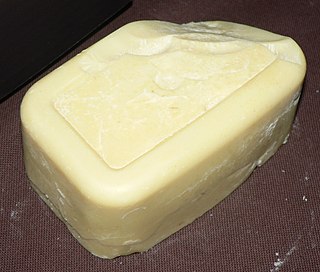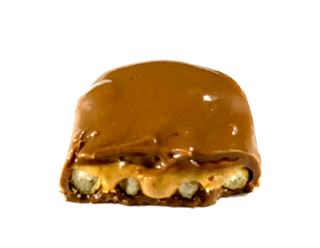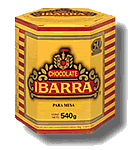Related Research Articles

Chocolate is a preparation of roasted and ground cacao seeds that is made in the form of a liquid, paste, or in a block, which may also be used as a flavoring ingredient in other foods. The earliest signs of use are associated with Olmec sites suggesting consumption of chocolate beverages, dating from the 19th century BC. The majority of Mesoamerican people made chocolate beverages, including the Maya and Aztecs. The English word "chocolate" comes, via Spanish, from the Classical Nahuatl word xocolātl.
Nutella is a brand of sweetened hazelnut cocoa spread. Nutella is manufactured by the Italian company Ferrero and was first introduced in 1964, although its first iteration dates to 1963.

The cocoa bean or simply cocoa, which is also called the cacao bean or cacao , is the dried and fully fermented seed of Theobroma cacao, from which cocoa solids and cocoa butter can be extracted. Cocoa beans are the basis of chocolate, and Mesoamerican foods including tejate, an indigenous Mexican drink that also includes maize.

A chocolate bar or candy bar is a confection containing chocolate, which may also contain layerings or mixtures that include nuts, fruit, caramel, nougat, and wafers. A wide variety of chocolate bar brands are sold. A popular example is a Snickers bar, which consists of nougat mixed with caramel and peanuts, covered in milk chocolate.

Chocolate milk is a sweetened chocolate-flavored milk. It can be made by mixing chocolate syrup with milk. It can be purchased pre-mixed with milk or made at home by blending milk with cocoa powder and a sweetener, melted chocolate, chocolate syrup, or a pre-made powdered chocolate milk mix. Other ingredients, such as starch, salt, carrageenan, vanilla, or artificial flavoring are sometimes added. To add nutritional value to the product, sometimes some minerals like zinc oxide or iron are added.

Hot chocolate, also known as hot cocoa or drinking chocolate, is a heated drink consisting of shaved chocolate, melted chocolate or cocoa powder, heated milk or water, and usually a sweetener. Hot chocolate may be topped with whipped cream or marshmallows. Hot chocolate made with melted chocolate is sometimes called drinking chocolate, characterized by less sweetness and a thicker consistency.

Cocoa butter, also called theobroma oil, is a pale-yellow, edible fat extracted from the cocoa bean. It is used to make chocolate, as well as some ointments, toiletries, and pharmaceuticals. Cocoa butter has a cocoa flavor and aroma. Its melting point is just below human body temperature.

Tupla is a Finnish chocolate bar made by Cloetta. It consists of milk chocolate with a nougat-flavoured filling, coated with bits of almond.

The Take 5 is a candy bar released by The Hershey Company in December 2004. The original name of the candy bar was TAKE5 but common usage among consumers added a space. In June 2019, when the candy bar became part of the Reese's family, the name officially was changed to Reese's Take 5. The "5" in the name refers to the combination of five ingredients: chocolate, peanuts, caramel, peanut butter, and pretzels. This unique combination of ingredients earned Reese's Take 5 top honors in the 2019 LA Times official candy bar power rankings. On February 2, 2020, Hershey's announced the creation of the world's largest chocolate and nut candy bar with a 5,943 pound bar measuring 9 feet in length. The Take5 was known as Max 5 in Canada but has since been discontinued. Take5 has returned to Canada in the fall of 2020, under the name "Oh Henry Level Up".
"Big Chocolate" is a business term assigned to multi-national chocolate food producers, akin to the terms "Big Oil," "Big Pharma," and "Big Tobacco".

Ibarra is a brand of Mexican chocolate para mesa produced by the company Chocolatera de Jalisco of Guadalajara, Jalisco, Mexico. The company manufactures other chocolate products, but Ibarra table chocolate is its best-known product, with presence throughout Mexico as well as international markets, mainly in the Americas, but also in parts of Europe. It is often found in gourmet shops.

Compound chocolate is a product made from a combination of cocoa, vegetable fat and sweeteners. It is used as a lower-cost alternative to true chocolate, as it uses less-expensive hard vegetable fats such as coconut oil or palm kernel oil in place of the more expensive cocoa butter. It may also be known as "compound coating" or "chocolatey coating" when used as a coating for candy. It is often used in less expensive chocolate bars to replace enrobed chocolate on a product.

Chocolate is a range of foods derived from cocoa (cacao), mixed with fat and finely powdered sugar to produce a solid confectionery. There are several types of chocolate, classified according to the proportion of cocoa used in a particular formulation.

Breakaway is a brand of chocolate-covered digestive biscuit from Nestlé, which started production in 1970.

The National Confectioners Association is an American trade organization that promotes chocolate, candy, gum and mints, and the companies that make these treats. As the leading association for the $35 billion U.S. confectionery industry, NCA educates the public to help ensure that it understands the role that chocolate and candy can play in a balanced lifestyle and lobbies the government. Confections are produced in all 50 states.
Hershey Kissables were a chocolate candy sold by The Hershey Company from late 2005 to 2009. Comparable to M&M's, Hershey Kissables were shaped like miniature Hershey's Kisses and were coated in a thick sugar shell.

Dry cocoa solids are the components of cocoa beans remaining after cocoa butter, the fatty component of the bean, is extracted from chocolate liquor, roasted cocoa beans that have been ground into a liquid state. Cocoa butter is 46% to 57% of the weight of cocoa beans and gives chocolate its characteristic melting properties. Cocoa powder is the powdered form of the dry solids with a small remaining amount of cocoa butter. Untreated cocoa powder is bitter and acidic. Dutch process cocoa has been treated with an alkaline to neutralize the acid.
The European Parliament and Council Directive 2000/36/EC is an EU Directive relating to cocoa and chocolate products. Most notably, this directive allows chocolate to contain up to 5% non-cocoa vegetable fats.

Cookie butter is a food paste made primarily from speculoos cookie crumbs, fat, flour, and sugar. The ingredients are mixed until it becomes spreadable on a sandwich. In countries like Belgium, the Netherlands, and France, it is a common alternative to nut butter and chocolate spreads. The most common brand name is Lotus Bakeries.

Commission v Italy (2003) C-14/00 is an EU law case, concerning the free movement of goods in the European Union.
References
- 1 2 "Chocolate Country". New York Times. 2006. Retrieved 20 May 2014.
- 1 2 "BELGIUM: Government encourages chocolate producers to support international quality label". just-food.com. 21 December 2000. Archived from the original on 19 May 2014. Retrieved 20 May 2014.
- ↑ "Ambao". IP Australia. Archived from the original on 19 May 2014. Retrieved 20 May 2014.